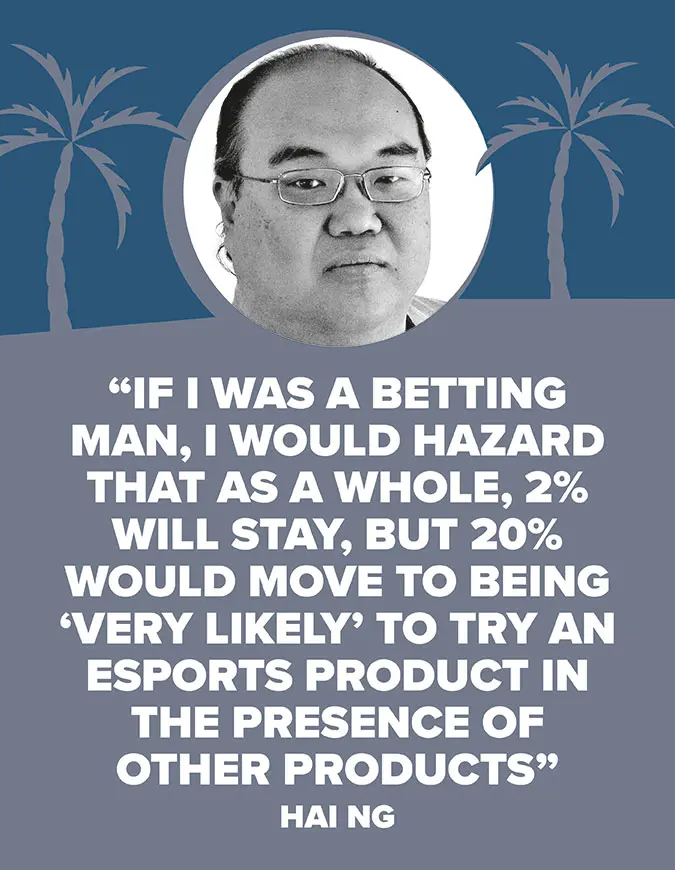

The absence of live traditional sports during the pandemic forced many through the open gates of esports, but while the surge in activity is now over for many sportsbooks, the phenomenon is no bubble, argues Hai Ng
It was a typical day near the end of October 2019. I had just started working on a new project to develop an esports strategy for an impressive stadium complex located in an up-and-coming major city in China. They had secured a series of traditional events but were looking to future-proof their calendar; esports was a natural idea. The team and I had just started to do our basic background research when my sources on the ground started sending me information about a new respiratory condition that appeared to be spreading in that city. As we were in the process of scheduling our ground visits, I sent an email flagging the reports and raised a caution on travel to the site. That city was Wuhan, and the respiratory condition was what is now named Covid-19. How the world has changed since. Interestingly, esports hasn’t changed that much in the shadow of the novel coronavirus, and that probably comes as no surprise, or at least quickly becomes obvious, to many who are endemic to the industry or have come to understand it. As an activity that was born in technology and found a home in the ether of the internet, video games and esports have become the refuge for many. Even for many critics and sceptics, the absence of organised physical sports forced many through the open gates of esports. Motorsports quickly turned to esports as a way to continue fan engagement. Within the first three weekends, Nascar encountered everything from troublesome, and occasionally funny, disconnections during a race, to drivers ‘rage-quitting’ and toxic behaviour leading to sponsorship withdrawals and firings – a quick but harsh lesson that organising esports tournaments isn’t just fun and games. To its credit, it did a great job recovering and registered very respectable viewing numbers, all things considered.

THRIVING IN AN UNCERTAIN WORLD
In a world blanketed by a pandemic desert that is changing how life and business is done, esports is looking like an oasis. For the gaming (yes, that would be gambling, the other gaming) industry, esports has also turned some eyes and kept some operations moving. With a number of physical sports trying out esports options and the sector continuing pretty much business as usual, many sportsbooks that have already embraced esports as a product have managed to continue revenue operations in the absence of physical sporting events. The spike was significant enough that even mainstream media jumped in to report on it. A Forbes article covered a report from the GB Gambling Commission stating that esports betting had jumped a massive 2,992% year-on-year, going from £50,000 in March 2020 to £4.9m in May. Even Las Vegas noticed an uptick in esports wagers with sportsbooks more actively pushing what was previously offered as something more exotic. This action was certainly boosted by the fact that many television channels, including sports networks, started more extensive coverage of esports in their need to fill airtime left empty by the lack of physical sporting events. Many who may have never considered watching or betting on esports were now given motivation to try it. Almost all igaming sportsbooks were reporting gains on their esports products, with articles quoting all the usual suspects including Isle of Man-licensed Luckbox and Unikrn. Sharing an online panel with global esports book leader Pinnacle, it was quickly apparent that the company is not only doing well with esports but growing its industry lead and further enhancing its product offerings in the sector. But the question then becomes: “is this a bubble?” Let me start by saying that esports itself, unequivocally, is not a bubble. That said, this current surge is definitely fuelled by variables that, when removed, will not make esports irrelevant but will very likely cause it to return to its original rate of growth, perhaps with a slight residual boost. Sports bettors can be split into two camps: casual and experienced. If we remove those customers already wagering on esports prior to entering this pandemic desert, I would hazard anecdotally that the bulk of the new converts belong to the experienced camp. These are customers who enjoy sports wagering or even engage in it professionally as a test of statistical skills and experience. These customers would be able to take esports like any other sporting event, analyse the available statistics and odds and use them to make a calculated wager. For these experienced customers, the potential for them staying with esports after we exit the pandemic will be much greater – if only for the simple reason that they now have first-hand experience with the product and an objective measure of their performance with it.